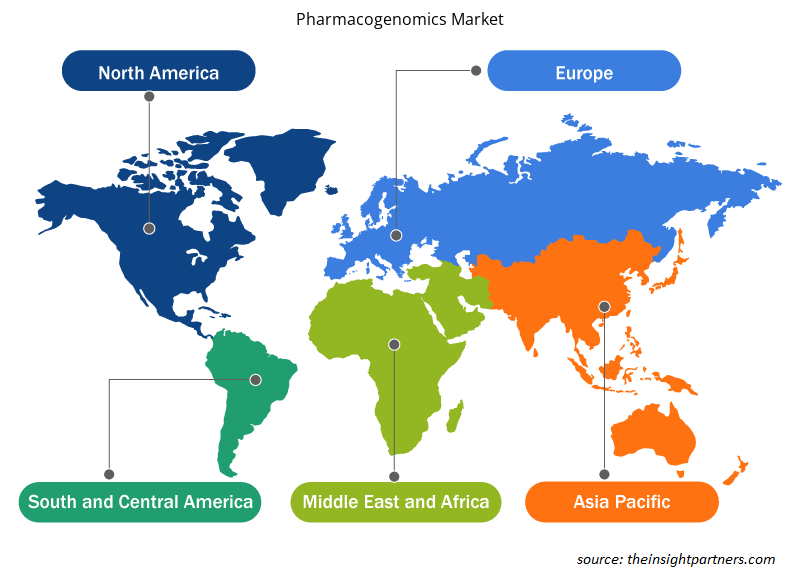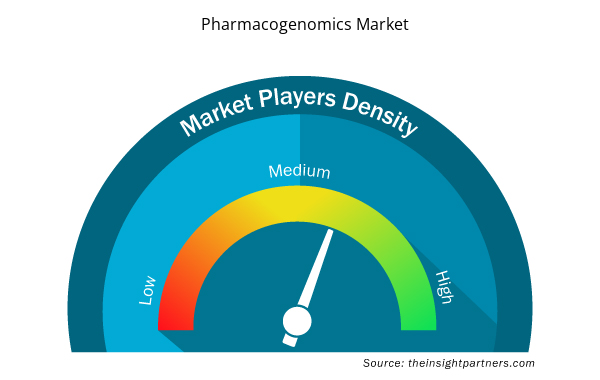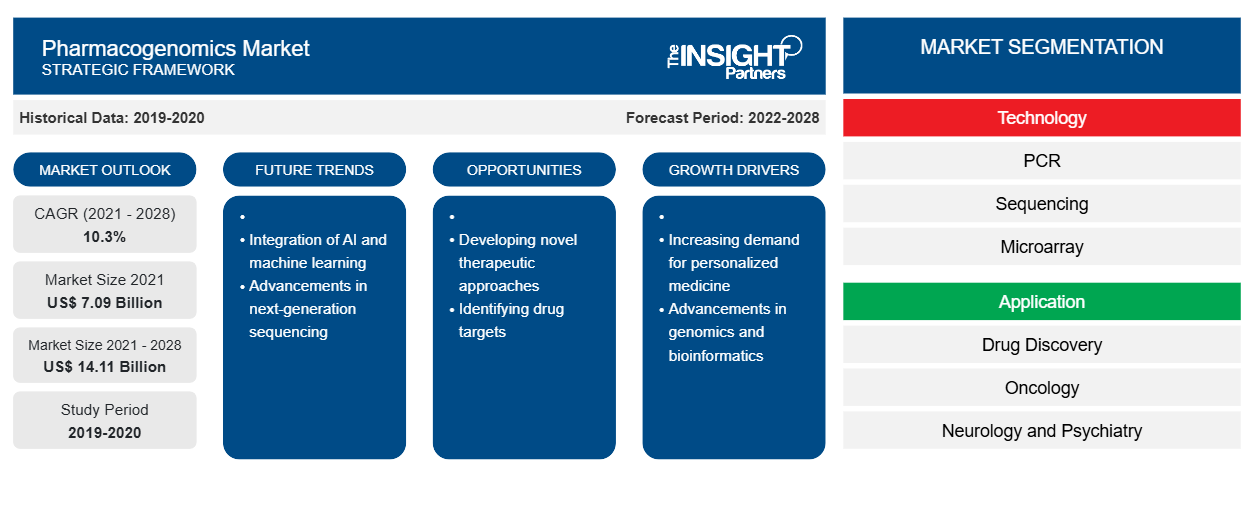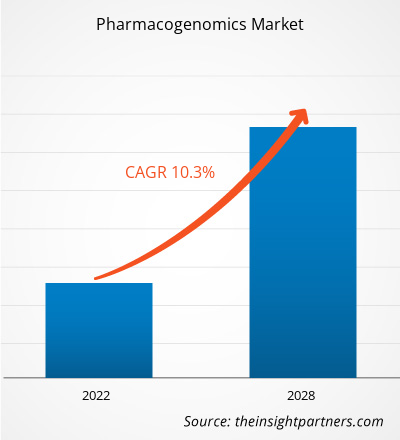Der Markt für Pharmakogenomik soll von 7.087,81 Millionen US-Dollar im Jahr 2021 auf 14.107,80 Millionen US-Dollar im Jahr 2028 anwachsen; von 2021 bis 2028 wird ein durchschnittliches jährliches Wachstum von 10,3 % erwartet.
Die zunehmende Verbreitung chronischer Krankheiten ist einer der wichtigsten Faktoren, die das Wachstum des Marktes vorantreiben. Viele ältere Erwachsene (> 60 %) leiden an zwei oder mehr chronischen Krankheiten. Zwillingsstudien haben ergeben, dass Gene chronische Krankheiten wie Herz-Kreislauf-Erkrankungen (CVDs), Diabetes, Fettleibigkeit, RA, Alzheimer-Krankheit (AD) und Depressionen verursachen können . Mithilfe molekulargenetischer Daten aus genomweiten Assoziationsstudien (GWAS) ist es nun möglich, die Risiken für diese chronischen Krankheiten auf individueller Ebene zu messen. Laut den Centers for Disease Control and Prevention (CDC) litten im Jahr 2020 fast 6 von 10 Menschen in den USA an mindestens einer chronischen Krankheit und 4 von 10 Menschen hatten zwei oder mehr chronische Krankheiten. Die zunehmende Inzidenz chronischer Krankheiten löst die Nachfrage nach pharmakogenomischen Technologien zur Entwicklung neuartiger Therapien aus.
Passen Sie diesen Bericht Ihren Anforderungen an
Sie erhalten kostenlos individuelle Anpassungen an jedem Bericht, einschließlich Teilen dieses Berichts oder einer Analyse auf Länderebene, eines Excel-Datenpakets sowie tolle Angebote und Rabatte für Start-ups und Universitäten.
- Holen Sie sich die wichtigsten Markttrends aus diesem Bericht.Dieses KOSTENLOSE Beispiel umfasst eine Datenanalyse von Markttrends bis hin zu Schätzungen und Prognosen.
Nordamerika wird voraussichtlich zwischen 2021 und 2028 den Pharmakogenomik-Markt dominieren . Die USA halten den größten Marktanteil in Nordamerika und dieser Trend wird sich im Prognosezeitraum voraussichtlich fortsetzen. Der Pharmakogenomik-Markt in den USA wird in den kommenden Jahren voraussichtlich wachsen, da die Forschungsaktivitäten zur Entwicklung von Präzisionsmedizin zur Behandlung von Krebs zunehmen, führende biopharmazeutische und pharmazeutische Unternehmen stärker präsent sind und die pharmakogenomische Forschung im Land zunimmt. Die Akzeptanzrate der pharmakogenomikbasierten Krebsbehandlung steigt kontinuierlich an und die führenden Marktteilnehmer führen mehrere neuartige Produkte ein, die mit diesem Ansatz verbunden sind. Auch die Unterstützung der Aufsichtsbehörden wird den Markt in den USA im Prognosezeitraum voraussichtlich ankurbeln. Derzeit untersuchen mehrere klinische Studien die Pharmakogenomik-Technologie zur Entwicklung präziser Medikamente und zur Verbesserung der Gesamtansprechrate der Behandlung. Im Mai 2021 genehmigte die US-amerikanische Food and Drug Administration (FDA) Lumakras (Sotorasib) für eine zielgerichtete Therapie für Patienten mit nicht-kleinzelligem Lungenkrebs mit Tumoren, die die G12C-Mutation im KRAS-Gen exprimieren.
Markteinblicke
Wachsende Finanzierung der pharmakogenomischen Forschung treibt Marktwachstum an
Die Genomsequenzierung wird in der klinischen Praxis immer häufiger eingesetzt. In den nächsten fünf Jahren werden im Gesundheitssystem voraussichtlich Genomdaten von über 60 Millionen Patienten generiert. Die Pharmakogenomik findet rasch Eingang in die klinische Praxis. Die Implementierung in Gesundheitssysteme wird durch staatliche Investitionen in Höhe von insgesamt über 4 Milliarden US-Dollar in mindestens 14 Ländern unterstützt.
Großbritannien hat das weltweit größte Genomprojekt als Teil einer 200 Millionen Euro umfassenden öffentlich-privaten Zusammenarbeit zwischen Wohltätigkeitsorganisationen und Pharmaunternehmen angekündigt. Das Land hat bereits im Rahmen der 100.000 Genomprojekte, die von Innovate UK als Teil der britischen Forschungs- und Innovationsinitiative geleitet werden, die größte Genomdatenbank der Welt entwickelt. Das Projekt wird Forscher und Unternehmen dabei unterstützen, Daten und reale Beweise aus dem britischen Gesundheitswesen zu kombinieren und neue Produkte und Dienstleistungen zu entwickeln, mit denen Krankheiten effizient diagnostiziert werden können.
Darüber hinaus gab die Boston Scientific Corporation, ein in Massachusetts ansässiges Unternehmen, im August 2018 bekannt, dass sie 4,3 Millionen US-Dollar an Startkapital erhalten und eine Partnerschaft mit Veritas Genetics eingegangen ist. Die Mittel werden die Mission des Unternehmens unterstützen, in das Zeitalter der persönlichen Genomsequenzierung einzutreten, indem ein vertrauenswürdiger, sicherer und dezentraler Marktplatz für Genomdaten geschaffen wird.
Technologiebasierte Erkenntnisse
Basierend auf der Technologie ist der Pharmakogenomik-Markt in PCR, Sequenzierung, Microarray, Gelelektrophorese, Massenspektrometrie und andere segmentiert. Der Markt für das PCR-Segment ist weiter segmentiert in Standard-PCR, Echtzeit-PCR und digitale PCR. Es wird erwartet, dass das PCR-Segment im Zeitraum 2021–2028 den größten Anteil des Pharmakogenomik-Marktes ausmachen wird. Die Polymerase-Kettenreaktion (PCR) ist eine häufig verwendete Technologie, um schnell Millionen bis Milliarden Kopien einer bestimmten DNA-Probe zu erstellen, sodass Wissenschaftler eine kleine DNA-Probe entnehmen und sie auf eine ausreichend große Menge amplifizieren können, um sie im Detail zu untersuchen. Die PCR-Technologien spielen eine Schlüsselrolle bei der Genklonierung und -manipulation, der DNA-Klonierung, der Genmutagenese, der Funktionsanalyse von Genen, der Erkennung von Krankheitserregern und der Arzneimittelresistenzprüfung. Verschiedene pharmazeutische und biopharmazeutische Unternehmen bieten PCR-Lösungen für pharmakogenomische und Arzneimittelentwicklungsanwendungen an. Beispielsweise bietet Thermo Fisher Scientific, Inc. Echtzeit-PCR-Lösungen für die pharmakogenomische Anwendung an.
Anwendungsbasierte Erkenntnisse
Basierend auf der Anwendung ist der Pharmakogenomik-Markt in Arzneimittelforschung, Onkologie, Neurologie und Psychiatrie, Schmerztherapie, Herz-Kreislauf-Erkrankungen und andere segmentiert. Das Segment Onkologie hält einen beträchtlichen Marktanteil und wird seine Dominanz im Prognosezeitraum voraussichtlich beibehalten. Die Krebspharmakogenomik hat mehrere wichtige Entdeckungen zur aktuellen Krebsbehandlung beigetragen und das Paradigma der Behandlungsentscheidungen verändert. Die Weltgesundheitsorganisation (WHO) gab an, dass Krebs im Jahr 2020 für etwa 10 Millionen Todesfälle verantwortlich sei. Darüber hinaus wird laut den Daten der American Cancer Society erwartet, dass die weltweite Belastung durch Karzinome bis zum Jahr 2040 auf 27,5 Millionen Neuerkrankungen und 16,3 Millionen Krebstote ansteigen wird. Solche hohen Zahlen zeigen, dass die steigende Krebsinzidenz eine Notwendigkeit für eine primitive Diagnose und vorbeugende Behandlung schafft. Es gibt zahlreiche Methoden wie PCR, INAAT und NGS, um Karzinome zu diagnostizieren. Die Erfindung der PCR (Polymerase-Kettenreaktion) führte zu einem enormen Fortschritt bei klinischen DNA-Tests. PCR-basierte Methoden erfordern unkomplizierte Instrumente und Infrastruktur, nutzen nur winzige Mengen biologischen Materials und sind weitgehend mit der klinischen Routine vereinbar. Die Anwendung der Pharmakogenomik in der Onkologie ist aufgrund des abnehmenden therapeutischen Index von Chemotherapeutika und des Risikos lebensbedrohlicher Nebenwirkungen von Bedeutung.
Endbenutzerbasierte Erkenntnisse
Basierend auf dem Endverbraucher ist der Pharmakogenomik-Markt in Krankenhäuser und Kliniken, biopharmazeutische Unternehmen, CROs und CDMOs und andere unterteilt. Das Segment der CROs und CDMOs hält einen beträchtlichen Marktanteil und wird voraussichtlich im Prognosezeitraum seine beherrschende Stellung beibehalten. Die Vertragsforschungsorganisation (CRO) hilft verschiedenen Unternehmen und Organisationen, indem sie klinische Studien ihrer entwickelten Produkte und Technologien durchführt, während die Vertragsentwicklungs- und -herstellungsorganisationen (CDMO) die Unternehmen bei der Entwicklung und Herstellung der Produkte unterstützen. Die CROs bieten Dienstleistungen wie Projektmanagement, Datenbankdesign und -aufbau, Dateneingabe und -validierung, Datenmanagement für klinische Studien, Medikamenten- und Krankheitskodierung, Qualitäts- und Metrikberichte, Pläne und Berichte zur statistischen Analyse, Validierungsprogrammierung sowie Zusammenfassungen zu Sicherheit und Wirksamkeit und Abschlussberichte zu Studien. CROs bieten auch einige andere Dienstleistungen wie Gendienste, Klondienste und Expression an.
Um den steigenden Kundenanforderungen weltweit gerecht zu werden, verfolgen auf dem Pharmakogenomik-Markt tätige Unternehmen eine anorganische Wachstumsstrategie, die Übernahmen, Fusionen und Kooperationen mit lokalen und internationalen Akteuren auf dem Weltmarkt umfasst.
Regionale Einblicke in den Pharmakogenomik-Markt
Die regionalen Trends und Faktoren, die den Pharmakogenomik-Markt im Prognosezeitraum beeinflussen, wurden von den Analysten von Insight Partners ausführlich erläutert. In diesem Abschnitt werden auch die Marktsegmente und die Geografie des Pharmakogenomik-Marktes in Nordamerika, Europa, im asiatisch-pazifischen Raum, im Nahen Osten und Afrika sowie in Süd- und Mittelamerika erörtert.

- Erhalten Sie regionalspezifische Daten zum Pharmakogenomik-Markt
Umfang des Marktberichts zur Pharmakogenomik
| Berichtsattribut | Details |
|---|---|
| Marktgröße im Jahr 2021 | 7,09 Milliarden US-Dollar |
| Marktgröße bis 2028 | 14,11 Milliarden US-Dollar |
| Globale CAGR (2021 - 2028) | 10,3 % |
| Historische Daten | 2019-2020 |
| Prognosezeitraum | 2022–2028 |
| Abgedeckte Segmente | Nach Technologie
|
| Abgedeckte Regionen und Länder | Nordamerika
|
| Marktführer und wichtige Unternehmensprofile |
|
Dichte der Akteure auf dem Pharmakogenomik-Markt: Auswirkungen auf die Geschäftsdynamik verstehen
Der Markt für Pharmakogenomik wächst rasant, angetrieben durch die steigende Nachfrage der Endverbraucher aufgrund von Faktoren wie sich entwickelnden Verbraucherpräferenzen, technologischen Fortschritten und einem größeren Bewusstsein für die Vorteile des Produkts. Mit steigender Nachfrage erweitern Unternehmen ihr Angebot, entwickeln Innovationen, um die Bedürfnisse der Verbraucher zu erfüllen, und nutzen neue Trends, was das Marktwachstum weiter ankurbelt.
Die Marktteilnehmerdichte bezieht sich auf die Verteilung der Firmen oder Unternehmen, die in einem bestimmten Markt oder einer bestimmten Branche tätig sind. Sie gibt an, wie viele Wettbewerber (Marktteilnehmer) in einem bestimmten Marktraum im Verhältnis zu seiner Größe oder seinem gesamten Marktwert präsent sind.
Die wichtigsten auf dem Pharmakogenomik-Markt tätigen Unternehmen sind:
- F. Hoffmann-la Roche Ltd
- Abbott
- Oxford Nanopore Technologien
- Thermo Fisher Scientific Inc.
- Illumina, Inc.
Haftungsausschluss : Die oben aufgeführten Unternehmen sind nicht in einer bestimmten Reihenfolge aufgeführt.

- Überblick über die wichtigsten Akteure auf dem Pharmakogenomik-Markt
Pharmakogenomik-Markt – Segmentierung
- Basierend auf der Technologie ist der Pharmakogenomik-Markt segmentiert in PCR, Sequenzierung, Microarray, Gelelektrophorese, Massenspektrometrie und andere. Der Markt für das PCR-Segment ist weiter segmentiert in Standard-PCR, Echtzeit-PCR und digitale PCR.
- Nach Anwendung ist der Markt für Pharmakogenomik in Arzneimittelforschung, Onkologie, Neurologie und Psychiatrie, Schmerzbehandlung, Herz-Kreislauf-Erkrankungen und andere unterteilt.
- Basierend auf dem Endbenutzer ist der Pharmakogenomik-Markt in Krankenhäuser und Kliniken, biopharmazeutische Unternehmen, CROs und CDMOs und andere segmentiert.
- Geografisch ist der Markt für intradermale Injektionen in Nordamerika (USA, Kanada und Mexiko), Europa (Frankreich, Deutschland, Italien, Großbritannien, Spanien und das übrige Europa), den asiatisch-pazifischen Raum (Australien, China, Indien, Japan, Südkorea und den Rest des asiatisch-pazifischen Raums), den Nahen Osten und Afrika (Saudi-Arabien, Südafrika, die Vereinigten Arabischen Emirate und den Rest des Nahen Ostens) sowie Süd- und Mittelamerika (Brasilien, Argentinien und den Rest der südamerikanischen und Pazifikregion) unterteilt.
F. Hoffmann-la Roche Ltd; Abbott; Oxford Nanopore Technologies; Thermo Fisher Scientific Inc; Illumina, Inc; QIAGEN; Agilent Technologies, Inc; Myriad Genetics, Inc; Admera Health und Dynamic DNA Laboratories sind einige Unternehmen, die auf dem pharmakogenomischen Markt tätig sind.
- Historische Analyse (2 Jahre), Basisjahr, Prognose (7 Jahre) mit CAGR
- PEST- und SWOT-Analyse
- Marktgröße Wert/Volumen – Global, Regional, Land
- Branche und Wettbewerbsumfeld
- Excel-Datensatz


- Photo Editing Software Market
- Medical Collagen Market
- Blood Collection Devices Market
- Precast Concrete Market
- HVAC Sensors Market
- Carbon Fiber Market
- Biopharmaceutical Contract Manufacturing Market
- Authentication and Brand Protection Market
- Compounding Pharmacies Market
- Nitrogenous Fertilizer Market

Report Coverage
Revenue forecast, Company Analysis, Industry landscape, Growth factors, and Trends

Segment Covered
This text is related
to segments covered.

Regional Scope
North America, Europe, Asia Pacific, Middle East & Africa, South & Central America

Country Scope
This text is related
to country scope.
Häufig gestellte Fragen
The global pharmacogenomics market based on technology is segmented into sequencing, PCR, gel electrophoresis, mass spectrometry, microarray, and others. In 2021, the PCR segment held the largest share of the market by technology and it is expected to witness fastest CAGR during 2021 to 2028, due to increasing utilization of this technology at global level.
The global pharmacogenomics market is segmented into North America, Europe, Asia Pacific, Middle East & Africa, and South & Central America. The North American area holds the largest market for pharmacogenomics. The United States held the most significant pharmacogenomics market and is expected to grow due to factors such as the increasing prevalence of chronic diseases and growing investments while the technological advancements by key players in pharmacogenomics is also boosting the growth rate in US.
The Asia Pacific region is expected to account for the fastest growth in the pharmacogenomics market. In Japan, India and South Korea, the market is expected to grow owing to the rapid development of research organizations and biopharmaceutical companies.
Several factors are believed to affect pharmacogenomics market in the coming years. Factors such as growing adoption of personalized therapies, increasing prevalence of chronic diseases, and growing funding in this sector are driving the market growth. However, lack of skilled professionals is likely to hamper the growth of the market.
The pharmacogenomics market majorly consists of the players such as F. Hoffmann-la Roche Ltd; Abbott; Oxford Nanopore Technologies; Thermo Fisher Scientific Inc.; Illumina, Inc.; QIAGEN; Agilent Technologies, Inc.; Myriad Genetics, Inc.; Admera Health; Dynamic DNA Laboratories among others..
Pharmacogenomics is a branch of science, which studies the role of gene over the activity of a drugs and hence helps the refreshers in predicting the response of novel as well as previously available therapies. Pharmacogenomics has direct application in the development of personalized medicine by testing single or multiple genes that are related to the disease. The main aim of this technology is to reduce the occurrence of treatment related adverse events and reduction in overall cost of treatment. The growing cases of ADRs and increasing demand of personalized therapies are expected to trigger the growth rate of this segment.
Trends and growth analysis reports related to Life Sciences : READ MORE..
The List of Companies - Pharmacogenomics Market
- F. Hoffmann-la Roche Ltd
- Abbott
- Oxford Nanopore Technologies
- Thermo Fisher Scientific Inc.
- Illumina, Inc.
- QIAGEN
- Agilent Technologies, Inc.
- Myriad Genetics, Inc.
- Admera Health
- Dynamic DNA Laboratories
The Insight Partners performs research in 4 major stages: Data Collection & Secondary Research, Primary Research, Data Analysis and Data Triangulation & Final Review.
- Data Collection and Secondary Research:
As a market research and consulting firm operating from a decade, we have published and advised several client across the globe. First step for any study will start with an assessment of currently available data and insights from existing reports. Further, historical and current market information is collected from Investor Presentations, Annual Reports, SEC Filings, etc., and other information related to company’s performance and market positioning are gathered from Paid Databases (Factiva, Hoovers, and Reuters) and various other publications available in public domain.
Several associations trade associates, technical forums, institutes, societies and organization are accessed to gain technical as well as market related insights through their publications such as research papers, blogs and press releases related to the studies are referred to get cues about the market. Further, white papers, journals, magazines, and other news articles published in last 3 years are scrutinized and analyzed to understand the current market trends.
- Primary Research:
The primarily interview analysis comprise of data obtained from industry participants interview and answers to survey questions gathered by in-house primary team.
For primary research, interviews are conducted with industry experts/CEOs/Marketing Managers/VPs/Subject Matter Experts from both demand and supply side to get a 360-degree view of the market. The primary team conducts several interviews based on the complexity of the markets to understand the various market trends and dynamics which makes research more credible and precise.
A typical research interview fulfils the following functions:
- Provides first-hand information on the market size, market trends, growth trends, competitive landscape, and outlook
- Validates and strengthens in-house secondary research findings
- Develops the analysis team’s expertise and market understanding
Primary research involves email interactions and telephone interviews for each market, category, segment, and sub-segment across geographies. The participants who typically take part in such a process include, but are not limited to:
- Industry participants: VPs, business development managers, market intelligence managers and national sales managers
- Outside experts: Valuation experts, research analysts and key opinion leaders specializing in the electronics and semiconductor industry.
Below is the breakup of our primary respondents by company, designation, and region:

Once we receive the confirmation from primary research sources or primary respondents, we finalize the base year market estimation and forecast the data as per the macroeconomic and microeconomic factors assessed during data collection.
- Data Analysis:
Once data is validated through both secondary as well as primary respondents, we finalize the market estimations by hypothesis formulation and factor analysis at regional and country level.
- Macro-Economic Factor Analysis:
We analyse macroeconomic indicators such the gross domestic product (GDP), increase in the demand for goods and services across industries, technological advancement, regional economic growth, governmental policies, the influence of COVID-19, PEST analysis, and other aspects. This analysis aids in setting benchmarks for various nations/regions and approximating market splits. Additionally, the general trend of the aforementioned components aid in determining the market's development possibilities.
- Country Level Data:
Various factors that are especially aligned to the country are taken into account to determine the market size for a certain area and country, including the presence of vendors, such as headquarters and offices, the country's GDP, demand patterns, and industry growth. To comprehend the market dynamics for the nation, a number of growth variables, inhibitors, application areas, and current market trends are researched. The aforementioned elements aid in determining the country's overall market's growth potential.
- Company Profile:
The “Table of Contents” is formulated by listing and analyzing more than 25 - 30 companies operating in the market ecosystem across geographies. However, we profile only 10 companies as a standard practice in our syndicate reports. These 10 companies comprise leading, emerging, and regional players. Nonetheless, our analysis is not restricted to the 10 listed companies, we also analyze other companies present in the market to develop a holistic view and understand the prevailing trends. The “Company Profiles” section in the report covers key facts, business description, products & services, financial information, SWOT analysis, and key developments. The financial information presented is extracted from the annual reports and official documents of the publicly listed companies. Upon collecting the information for the sections of respective companies, we verify them via various primary sources and then compile the data in respective company profiles. The company level information helps us in deriving the base number as well as in forecasting the market size.
- Developing Base Number:
Aggregation of sales statistics (2020-2022) and macro-economic factor, and other secondary and primary research insights are utilized to arrive at base number and related market shares for 2022. The data gaps are identified in this step and relevant market data is analyzed, collected from paid primary interviews or databases. On finalizing the base year market size, forecasts are developed on the basis of macro-economic, industry and market growth factors and company level analysis.
- Data Triangulation and Final Review:
The market findings and base year market size calculations are validated from supply as well as demand side. Demand side validations are based on macro-economic factor analysis and benchmarks for respective regions and countries. In case of supply side validations, revenues of major companies are estimated (in case not available) based on industry benchmark, approximate number of employees, product portfolio, and primary interviews revenues are gathered. Further revenue from target product/service segment is assessed to avoid overshooting of market statistics. In case of heavy deviations between supply and demand side values, all thes steps are repeated to achieve synchronization.
We follow an iterative model, wherein we share our research findings with Subject Matter Experts (SME’s) and Key Opinion Leaders (KOLs) until consensus view of the market is not formulated – this model negates any drastic deviation in the opinions of experts. Only validated and universally acceptable research findings are quoted in our reports.
We have important check points that we use to validate our research findings – which we call – data triangulation, where we validate the information, we generate from secondary sources with primary interviews and then we re-validate with our internal data bases and Subject matter experts. This comprehensive model enables us to deliver high quality, reliable data in shortest possible time.


 Holen Sie sich ein kostenloses Muster für diesen Bericht
Holen Sie sich ein kostenloses Muster für diesen Bericht